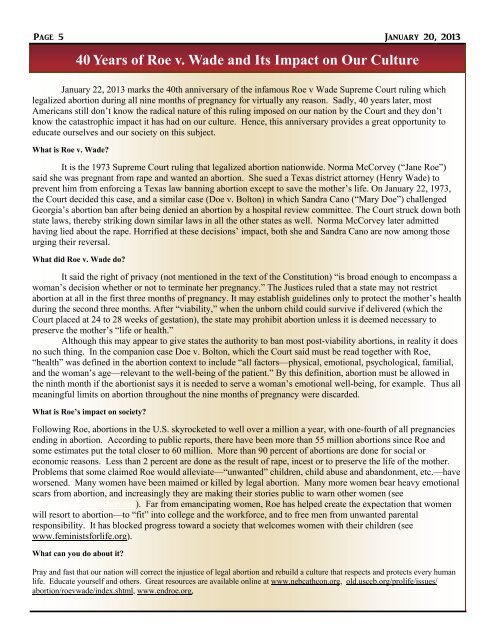Create successful ePaper yourself
Turn your PDF publications into a flip-book with our unique Google optimized e-Paper software.
P[g_ 5 J[nu[ry 20, 2013<br />
January 22, 2013 marks the 40th anniversary of the infamous Roe v Wade Supreme Court ruling which<br />
legalized abortion during all nine months of pregnancy for virtually any reason. Sadly, 40 years later, most<br />
Americans still don’t know the radical nature of this ruling imposed on our nation by the Court and they don’t<br />
know the catastrophic impact it has had on our culture. Hence, this anniversary provides a great opportunity to<br />
educate ourselves and our society on this subject.<br />
What is Roe v. Wade?<br />
40 Years of Roe v. Wade and Its Impact on Our Culture<br />
It is the 1973 Supreme Court ruling that legalized abortion nationwide. Norma McCorvey (“Jane Roe”)<br />
said she was pregnant from rape and wanted an abortion. She sued a Texas district attorney (Henry Wade) to<br />
prevent him from enforcing a Texas law banning abortion except to save the mother’s life. On January 22, 1973,<br />
the Court decided this case, and a similar case (Doe v. Bolton) in which Sandra Cano (“Mary Doe”) challenged<br />
Georgia’s abortion ban after being denied an abortion by a hospital review committee. The Court struck down both<br />
state laws, thereby striking down similar laws in all the other states as well. Norma McCorvey later admitted<br />
having lied about the rape. Horrified at these decisions’ impact, both she and Sandra Cano are now among those<br />
urging their reversal.<br />
What did Roe v. Wade do?<br />
It said the right of privacy (not mentioned in the text of the Constitution) “is broad enough to encompass a<br />
woman’s decision whether or not to terminate her pregnancy.” The Justices ruled that a state may not restrict<br />
abortion at all in the first three months of pregnancy. It may establish guidelines only to protect the mother’s health<br />
during the second three months. After “viability,” when the unborn child could survive if delivered (which the<br />
Court placed at 24 to 28 weeks of gestation), the state may prohibit abortion unless it is deemed necessary to<br />
preserve the mother’s “life or health.”<br />
Although this may appear to give states the authority to ban most post-viability abortions, in reality it does<br />
no such thing. In the companion case Doe v. Bolton, which the Court said must be read together with Roe,<br />
“health” was defined in the abortion context to include “all factors—physical, emotional, psychological, familial,<br />
and the woman’s age—relevant to the well-being of the patient.” By this definition, abortion must be allowed in<br />
the ninth month if the abortionist says it is needed to serve a woman’s emotional well-being, for example. Thus all<br />
meaningful limits on abortion throughout the nine months of pregnancy were discarded.<br />
What is Roe’s impact on society?<br />
Following Roe, abortions in the U.S. skyrocketed to well over a million a year, with one-fourth of all pregnancies<br />
ending in abortion. According to public reports, there have been more than 55 million abortions since Roe and<br />
some estimates put the total closer to 60 million. More than 90 percent of abortions are done for social or<br />
economic reasons. Less than 2 percent are done as the result of rape, incest or to preserve the life of the mother.<br />
Problems that some claimed Roe would alleviate—“unwanted” children, child abuse and abandonment, etc.—have<br />
worsened. Many women have been maimed or killed by legal abortion. Many more women bear heavy emotional<br />
scars from abortion, and increasingly they are making their stories public to warn other women (see<br />
www.hopeafterabortion.org). Far from emancipating women, Roe has helped create the expectation that women<br />
will resort to abortion—to “fit” into college and the workforce, and to free men from unwanted parental<br />
responsibility. It has blocked progress toward a society that welcomes women with their children (see<br />
www.feministsforlife.org).<br />
What can you do about it?<br />
Pray and fast that our nation will correct the injustice of legal abortion and rebuild a culture that respects and protects every human<br />
life. Educate yourself and others. Great resources are available online at www.nebcathcon.org, old.usccb.org/prolife/issues/<br />
abortion/roevwade/index.shtml, www.endroe.org,
















